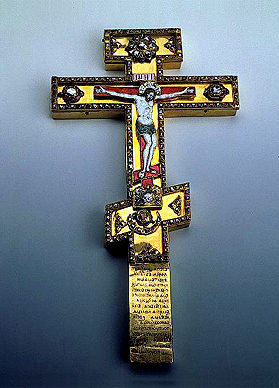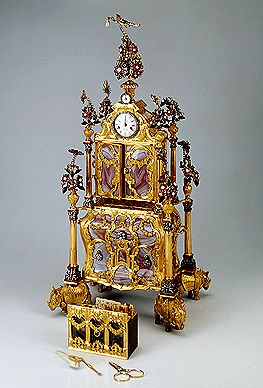I should probably start this with a disclaimer that the entire time I was in the Diamond Rooms at the State Hermitage Museum in St. Petersburg, I thought I was in the Gold Rooms. I think I expected more extravagant jewels in halls called the Diamond Rooms.
And there was a lot of gold.
I visited the Hermitage on the first Thursday of October, when admission was free for all. For that reason, I decided to splurge on a visit to one of the Treasury Gallery rooms – the Gold and Diamond Rooms can be visited only via a guided tour, costing 300 rubles per room. Most tours are in Russian, but there was one tour in English for each on the day I visited.
The tour covered nearly all of the displays in the five halls that made up the Diamond Rooms, with detailed explanation from a petite white-hired woman who went by Madame something-ova. In between calling everything fantastic or gorgeous, she told us about the culture of the Scythians in the 4th century B.C., the diplomatic gifts presented to the Russian court over the years, Catherine the Great’s taste in jewelry and the meaning behind the design of Russian Orthodox crosses.
 I heard all about a large gold vase dating back to the 4th century B.C. and gold jewelry with such fine detail, a magnifying glass was needed to appreciate it.
I heard all about a large gold vase dating back to the 4th century B.C. and gold jewelry with such fine detail, a magnifying glass was needed to appreciate it.
I listened to the story behind a horse blanket and sword given to the Russian court by a Sultan of Turkey consisting of over 8,000 brilliant cut diamonds.
I learned about a series of swords belonging to the Romanov family, each with handles covered in jewels, which left me wondering how they held the swords without the jewels cutting into their hands.
I saw a gold music box with a clock, hiding a manicure set on the interior.
 I peered closely at incredibly delicate pieces made in Russia commissioned by Catherine the Great from foreign artists – tiny boxes with even tinier portraits painted on the lids, many in honor of her son, Paul.
I peered closely at incredibly delicate pieces made in Russia commissioned by Catherine the Great from foreign artists – tiny boxes with even tinier portraits painted on the lids, many in honor of her son, Paul.
I saw agate and gold rings from the 18th century belonging to Empress Elizabeth Petrovna and Catherine the Great.
I saw snuff boxes, brooches and watches made in England, France, Switzerland and Germany, all given to the Russian tsars as diplomatic gifts. Some featured exquisitely detailed enamel paintings; others displayed gaudy amethysts, garnets, emeralds and diamonds. I learned that the French tended to be more understated in their gifts than the English. Madame Tour Guide commented that the English gifts were gaudy.
 I dropped my jaw looking at the complete toilet set of a niece of Peter the Great –consisting of a large mirror, coffee set, washing set, powder cases, hair brush and jewelry cases, made out of 40 kilograms of pure gold.
I dropped my jaw looking at the complete toilet set of a niece of Peter the Great –consisting of a large mirror, coffee set, washing set, powder cases, hair brush and jewelry cases, made out of 40 kilograms of pure gold.
Overall, I saw and learned more in an hour and 10 minutes in the Diamond Room than I do in most museums I visit.
They do not allow pictures to be taken in the Diamond Rooms, so the images above are used from www.hermitagemuseum.org, courtesy of the State Hermitge Museum, St. Petersburg, Russia.
